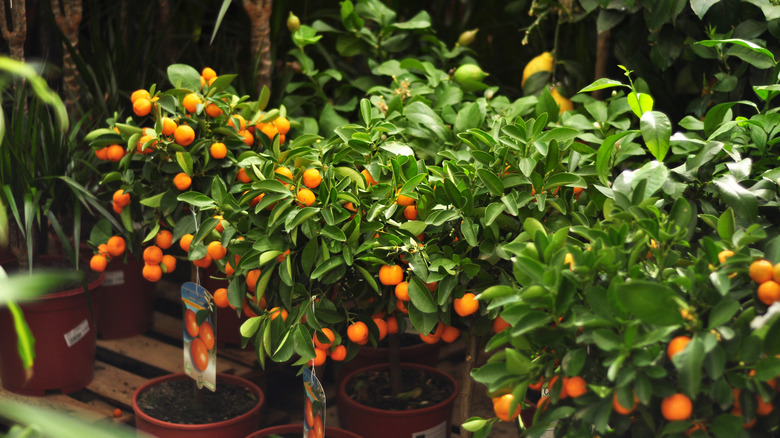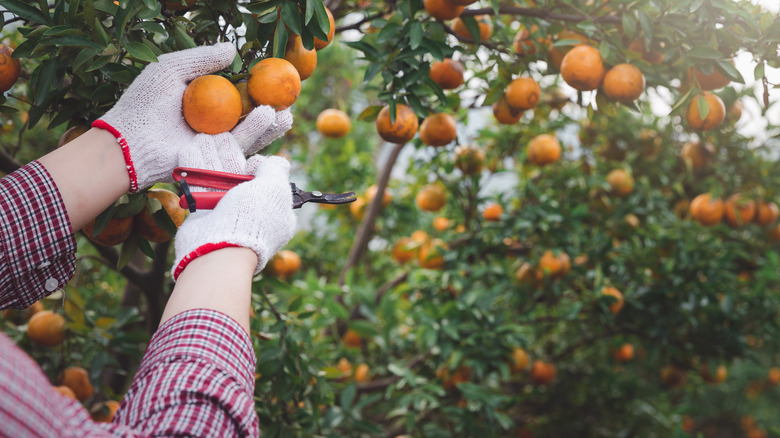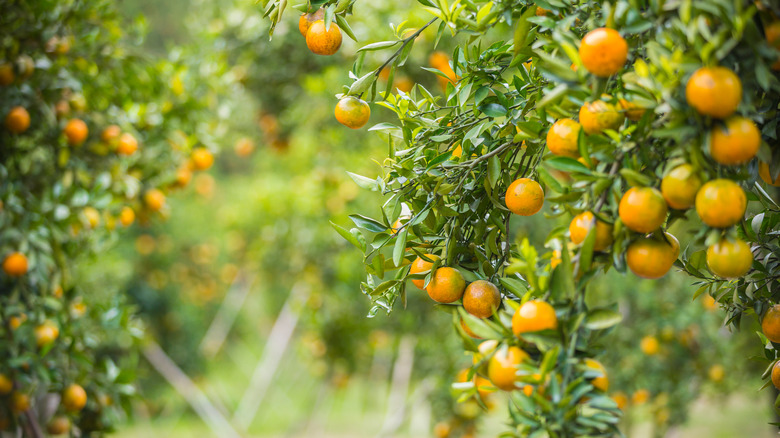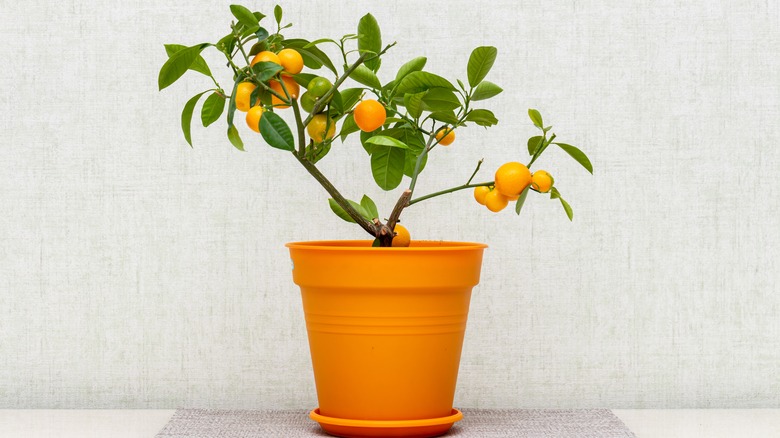How To Grow And Care For An Orange Tree
There's nothing like a glass of fresh-squeezed orange juice, except a glass of fresh-squeezed orange juice made with oranges that you grew. Having your own citrus sinensis (otherwise known as orange or sweet orange) tree is the best way to get your hands on that delicious, fresh-squeezed taste. Despite what you may think, these trees are actually quite easy to grow and care for if you have the right conditions to do so. In fact, even those that live in frigid climates, according to Brighter Blooms, can successfully grow a healthy and bountiful tree. Gardening Know How says to keep in mind that it takes anywhere from three to five years for an orange tree to start producing — so don't get too frustrated if your tree isn't instantly bursting with the tasty orange fruit.
Whether you're a novice or an expert citrus grower, it's important to stay up-to-date on your orange-tree knowledge so that you can enjoy the freshest, most delicious oranges for a long, long time. If you're unsure where to start or simply need a refresher, here is everything you need to know about growing and caring for an orange tree.
How to grow an orange tree
According to MasterClass, the best time to plant oranges depends on your climate. If you live in an area that experiences frost, instructor Ron Finley recommends waiting about a month and a half after the last frost before planting. During this time, the air and soil temperatures are consistently warm. If you live in the commercial citrus belt (which extends from Florida to Southern California), however, feel free to plant your oranges any time of year. If you can't find seeds at your local nursery or garden store, you can extract seeds straight from your orange fruit.
To plant your tree from seeds, MasterClass says to first soak your seeds for a minimum of 24 hours before planting. Prepare your soil with a traditional potting mix, then place the soil in trays, making about a one-inch-deep hole in each tray. Cover the hole with soil and add any additional compost, mulch, or nutrients you wish.
After your seeds have been planted, place them in a warm, moist spot where they can receive direct sunlight. To keep the soil moist, place moist plastic bags or paper towels over the trays for a couple of weeks, and remove them once the seeds start to sprout. Maintain your seeds in a nice, warm spot with lots of sunlight.
How to care for an orange tree
Keeping your tree hydrated is one of the most significant factors in growing and caring for your orange tree. How often you should water your tree depends on its age and growing conditions, according to Tree Journey. For younger trees, you should water them every few days. If you have a more mature tree, you can water it anywhere from once a week to once a month. The University of Arizona College of Agriculture recommends the basin irrigation method to ensure your tree is staying hydrated and healthy.
As with any citrus tree, choosing the right fertilizer is essential to growing and caring for your orange tree. For orange trees, University of Florida suggests phosphate fertilizer, which helps plants store and use energy, develop roots, speed maturity, and resist stress. According to Louisiana State University College of Agriculture, when it comes to fertilizing, a simple rule of thumb is the 8-8-8 (or 13-13-13) method. When it comes to how often you should fertilize, just like its watering schedule, an orange tree's fertilizing schedule depends on its age and climate.
Pruning is necessary to prolong life and maintain a healthy tree. Blooming Desert states that while orange trees don't require as much pruning as other citrus trees, you still need to remove any dead branches, along with any that cross or touch the ground. If you want to go the extra mile, you can remove some of the tree's interior branches as well, which encourages light and air to penetrate the innermost parts of the tree.
Are orange trees toxic?
Orange trees are well-known for being non-toxic to humans. In fact, Nature & Garden says oranges hold a ton of health benefits in addition to their delicious citrus taste. Bitter tree leaves can be used to fight stomach cramps, hacking cough, and even alleviate spasms. If you're looking for something to help with stress, orange essential oil has stress-relieving properties; and the orange fruit itself can soothe an upset digestive tract and increase digestion.
Unfortunately, there are some cases where gardeners incorrectly use pesticides that can make the tree toxic if the problem isn't dealt with immediately, according to Garden Guides. When it comes to pets, orange trees are generally safe for all animals; however, calamondin oranges are highly toxic to dogs. Tartar Shield states that these oranges produce limonene and linalool, which are known as highly toxic substances to our canine friends. If ingested, your dog may experience cold limbs, diarrhea, lethargy, and tremors, so be cautious when choosing where to plant this fruit.
How to repot your orange tree
Before you learn how to repot your orange tree, you need to know why repotting is important. Garden Health says repotting your tree helps to reimburse the plant with essential nutrients, which in turn promotes growth and fruit production. Springtime is ideal for repotting your orange tree, but you can choose to repot them anytime during the summer as well.
To repot your orange tree, Garden Health suggests using a pot that is 25% larger than the current one with excellent drainage holes. To ensure good drainage, place broken pot pieces at the bottom of the new pot and cover it with your choice of potting mix (preferably one that contains Seramis granules for optimum water and nutrient availability). Before placing the tree into the new pot, cut off any brown roots. Finally, fill the remainder of the pot with potting mix or compost, making sure the top feeder roots are covered with at least 2cm of whichever you choose. Keep the tree in light shade and water it well for a few weeks to allow its roots to grow.




